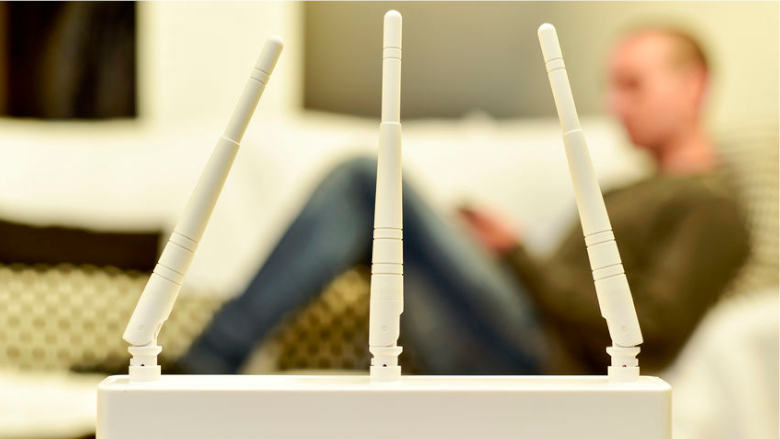
Home networking technology is improving fast enough that the wireless router you bought a few years ago simply won’t cut it for the growing number of Internet-connected devices that accumulate in our homes. When you aren’t getting what you pay for out of your Internet service, then it is time to upgrade to a tri-band router so your devices can perform to their highest potential.

|
Amazon Customer Reviews
|
Price: $499.99 Shop at Amazon | Shop now Read our review |

|
Amazon Customer Reviews
|
Price: $598.88 Shop at Amazon | Shop now Read our review |
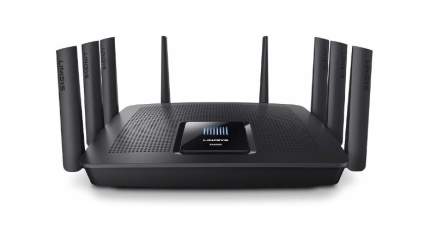
|
Amazon Customer Reviews
|
Price: $393.99 Shop at Amazon | Shop now Read our review |
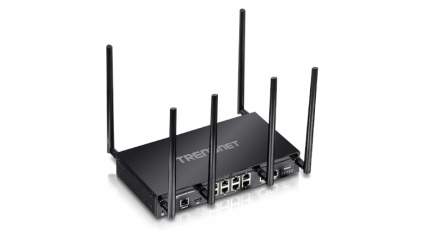
|
Amazon Customer Reviews
|
Price: $259.99 Shop at Amazon | Shop now Read our review |
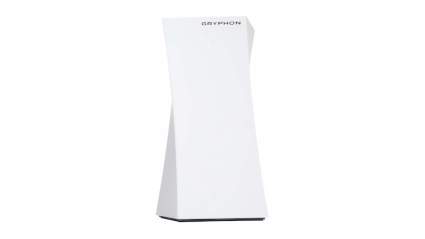
|
Amazon Customer Reviews
|
Price: $153.44 Shop at Amazon | Shop now Read our review |
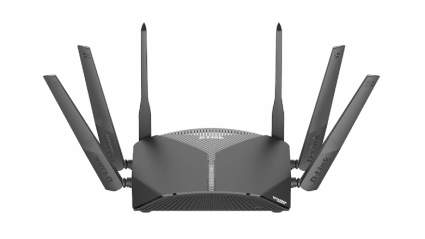
|
Amazon Customer Reviews
|
Price: $44.00 Shop at Amazon | Shop now Read our review |
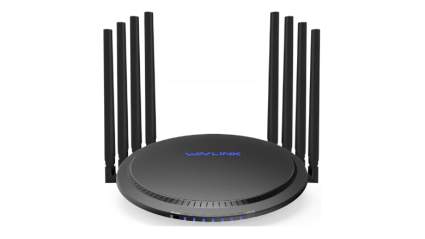
|
Amazon Customer Reviews
|
Price: $59.99 Shop at Amazon | Shop now Read our review |
-
1. Netgear Nighthawk AX12
Pros:- 12×12 MU-MIMO connections
- Large 2,500 sq. ft. coverage area
- Supports multi-gig speeds
Cons:- High price tag
- App GUI could be better
- Basic QoS
If your household has a lot of high-traffic devices connected to one network, the Netgear Nighthawk AX12 is a great choice for a home router. It supports MU-MIMO (multi-user multiple-input and multiple-output) for up to 12 devices without having to alternate streams. As long as your router placement and Internet plan permit it, this device can virtually eliminate local web traffic, which is great news when several people want to stream 4K content at once.
This router can potentially deliver a throughput of 2.5 Gbps to any one device thanks to this device’s 2.5 Gbps WAN port. Unfortunately, multi-gig Internet packages won’t be available until the fiber-optic infrastructure has been vastly improved. You can, however, achieve multi-gig file transfer speeds across your local wired network thanks to link aggregation technology. The last two of its four 1 Gbps ethernet ports can be merged to support transfer speeds of 2 Gbps with or without multi-gig Internet backing it up. The AX12 has two USB 3.0 ports for NAS (Network-Attached Storage) devices.
With all this in mind, it should be no surprise that the AX12 packs the wireless signal output to match this device’s insane speeds. Its antennas can broadcast to an area of 2,500 square feet, offering adequate coverage for most medium-to-large homes. This figure can be heavily impacted by physical obstacles like walls and nearby interference but is impressive nonetheless. And because this is a tri-band router it can support upwards of 40 devices at once, making this a great router for homes using IOT devices.
This router is highly configurable under the hood, making it a great choice for the power user who likes to control how their home Internet traffic functions. It supports useful functions like parental controls, guest networks, DoS, firewalls, and VPNs. It supports QoS too but you have to manually choose which devices get prioritized. The biggest downside is that these are primarily accessed through the Netgear Nighthawk app, whose GUI leaves a lot to be desired from those who have known better.
As impressive as this router is, it is overkill for most home networks. That said, if you stream or game hard enough to warrant buying a router this expensive, then you might as well get this one. Unless all of your home devices are already Wi-Fi 6, that is.
-
2. Asus ROG Rapture GT-AC5300
Pros:- 2 USB 3.0 ports and 8 LAN ports
- 4×4 MU-MIMO connections
- Supports multi-gig speeds
Cons:- High price tag
- Requires firmware upgrades and configuration out of the box
- Glitchy UI
The Asus ROG Rapture GT-AC5300 may look ridiculously similar to the Dark Tower that houses the Eye of Sauron but it is actually a tri-band router that is powerful enough to meet the needs of most any Internet power user. Its dual 5 GHz and single 2.4 GHz networks offer a combined maximum throughput of 5 Gbps, while its 4×4 MU-MIMO technology ensures that the four most high-demand devices can each have their own simultaneous streams. You may pay a premium price because of the Republic of Gaming branding but some of the features that are specific to the ROG line are actually quite useful.
Now, about that special software. The most intriguing feature of the GT-AC5300 is the VPN Fusion software. It enables you to run a VPN and ordinary internet connection simultaneously, effectively maximizing your connection speed to gaming servers. This router is also compatible with Asus AiMesh, which allows you to use other Asus routers to form a mesh network in your home regardless of model. Less useful, though, is the Game IPS, which is more or less marketing fluff. Just keep in mind the UI could be organized a lot better.
Even if you unbox this router and set it up without tweaking any of the settings it will still run quite well. Its eight antennas are great for carrying a signal throughout a house as its estimated coverage is around 5,000 square feet. This figure is quite loose, though, as your house’s layout and building material can have a major impact on it. It also has loads of connectivity options between its eight 1 Gbps LAN ports and two USB 3.0 ports. Two of these LAN ports support link aggregation, which enables you to send data across two ethernet cables simultaneously for multi-gig transfer speeds. If you can look past the idiosyncratic design and the fact that this is a piece of specialty gaming gear, there are a lot of sweet benefits for going with the GT-AC5300.
-
3. Linksys Max-Stream AC5400
Pros:- Large 3,000 sq. ft. coverage area
- 2×2 MU-MIMO connections
- 2 USB 2.0/3.0 ports and 8 LAN ports
Cons:- No link aggregation
- No VPN server support
- Large footprint
This model is powerful, without the frills of other options. The Linksys Max-Stream AC5400 has all the same high-performance networking capabilities as other top-tier tri-band routers without all of the frilly designs and features associated with gear that would normally be branded towards gamers. Well, racing stripe or no, this router delivers a high max throughput and an impressive coverage area. Considering its eight beamforming antennas and massive desk footprint, it should come as no surprise that this router has a wide coverage area—3,000 square feet if their marketing is to be believed.
Of course, router placement and building materials play a large factor in this so you will probably see more modest numbers in testing. This device’s tri-band signal houses three separate networks, which allows it to more easily split the load between different devices based on their needs. You should have no issue connecting upwards of 25 devices wirelessly to this router, plus eight more wired into its 1 Gbps ethernet ports. The Max-Stream AC5400 also has one USB 3.0 port and one USB 2.0 port, which is handy for setting up a NAS device. This device supports 2×2 MU-MIMO connections, which allows it to simultaneously stream to the two largest users of bandwidth. This helps to reduce local web traffic, especially for the alpha-gamer of the house.
The Max-Stream AC5400 is fairly easy to set up, as you can use either the LinkSys app or a web UI. From there you can easily access basic settings for guest networks, QoS prioritization, and parental controls. Unfortunately, these settings are fairly barebones and won’t satisfy power users who have been spoiled by sophisticated DDWRT interfaces. The parental controls, for example, only allow you to block specific sites and allow scheduled use. The router also doesn’t support VPN servers. But if you are looking for raw performance without the hassle of add-on features, this is a solid pick.
-
4. TRENDnet TEW-829DRU Tri-Band Router
Pros:- Flexible OpenWrt user interface
- 2×2 MU-MIMO connections
- 1 USB 3.0 port and 8 LAN ports
Cons:- Somewhat tricky setup
- No multi-gig support
- Antennas don't hold in place well
The TRENDnet TEW-829DRU is a tri-band router that offers midrange performance and a high-end user interface at a price that is pretty hard to beat. The router’s hardware offers the minimum 3 Gbps throughput that you should expect from a tri-band network and it should be strong enough to provide a signal across most medium-sized homes when placed in a central location. It also has 2×2 MU-MIMO support. This much can be expected from just about any tri-band router but where the TEW-829DRU truly goes above and beyond is its interface.
This router uses OpenWrt software for setup and configuration, which is one of the most customizable and feature-packed user interfaces available. It is in the same family of open-source software as DD-WRT and Tomato, so its code is constantly updated and audited by the community. The features that are available through this UI are too numerous to list but I do find a couple to be specifically useful. It can host VPN servers, connect to camera systems, access Dynamic DNS providers, along with other features you can browse here.
Unfortunately, the tradeoff of these extra features is that they require a more involved setup than routers that are meant to be more user-friendly. You’ll find plenty of support online if you do decide to take this on OpenWrt but technophobes will find better options in this price range. It is worth learning if you want to get the maximum usage out of the TEW-829DRU’s eight 1 Gbps LAN ports and two 1 Gbps WAN ports. This device also has a USB 3.0 port for NAS devices.
-
5. Gryphon AC3000 Tri-Band Router
Pros:- 4×4 MU-MIMO connections
- Large 3,000 sq. ft. coverage
- Solid parental controls and security
Cons:- No USB port for NAS devices
- No multi-gig support
- No web UI available
Despite its utter lack of bulky external antennas, the Gryphon AC3000 Tri-Band Router is actually capable of providing wireless Internet to a surprisingly large area. It supposedly covers about 3,000 square feet. In practice, it is likely to be less because of interference from furniture and other wireless devices, though it is impressive nonetheless. And if your only fiber optic or cable line is in an awkward part of your house, you can link this router up with other Gryphon routers to easily form a mesh network and extend your coverage. But for most cases, just one of these routers will suffice.
This router supports a max throughput of 3 Gbps between its single 2.4 GHz band and its dual 5 GHz bands. It can easily support upwards of 25 devices concurrently, with the four most active devices each getting their own concurrent stream thanks to 4×4 MU-MIMO support. It has three 1 Gbps LAN ports and one 1 Gbps WAN port on the rear. For most folks, this is enough but those with a home office may need a switch to connect additional devices. And unfortunately, this device does not have a USB port for NAS devices.
Setup is quite easy but you are required to go through the Gryphon app. Some will be disappointed by the lack of web portal or console port but these are ultimately security risks that should eventually be phased out. The router has basic settings for QoS, guest networks, and more, and they are all fairly easy to access through the app. And though its parental controls aren’t perfect, it has some of the most in-depth parental control settings I’ve seen built into a router. If only it had a better way to track individual user history beyond the domain name. Since I mentioned security earlier too, I should probably mention that this is also one of the most secure routers I’ve reviewed too. It has no default passwords, new device control, and all of its ports are stealthed by default.
If you are looking for a smart router that makes it easier to regulate how your family uses the Internet, then this is a great choice. As an added plus, I really appreciate the modern design and the neat white LED underglow.
-
6. D-Link Exo Mesh DIR-3040
Pros:- 2×2 MU-MIMO connections
- Mesh Wi-Fi compatible with other D-Link routers
- Easy setup with auto updates
Cons:- Antivirus and Alexa features log personal data
- Limited parental controls
- No VPN server
Though D-Link doesn’t carry the same brand recognition as big players like Netgear or Linksys, their D-Link Exo Mesh is just as capable of delivering gigabit speeds across a tri-band signal. This router supports a total max throughput of 3 Gbps and backs that up with a wide signal range, making this an appropriate choice for most medium-sized homes (as long as the layout isn’t too labyrinthine). We didn’t get an official figure for its estimated coverage but this router had no issue broadcasting across a 2,500 square foot home in testing.
Its tri-band signal is incredibly useful for reducing both congestion and interference, which are common issues in houses with lots of devices and nearby neighbors in the same situation. The 2.4 GHz band tends to be crowded by older devices so it really helps to connect any dedicated gaming or streaming devices to one of the two 5 GHz bands. This way they perform the best they possibly can. The D-Link Exo Mesh supports 2×2 MU-MIMO connections so that your network’s two top users can receive simultaneous streams without interference. It has one USB 3.0 port and one USB 2.0 port for NAS devices, four 1 Gbps ethernet ports, and one 1 Gbps WAN port. These specs are great to see at this price point but the real selling point of this router seems to be its sheer ease of use.
The D-Link Exo Mesh is designed to be super easy for new users to set up, which is great in some respects but bad in others. The good is that this router can be set up in minutes using the D-Link mobile app. The bad is that this router has a very limited set of features, and therefore, won’t offer as many benefits to the power user. If you want to establish a VPN server or specially customize a guest network, there are definitely better options out there. And the features that are there just seem clunky. The included 5-year subscription to McAfee Antivirus cannot be disabled once activated and requires you to submit your browsing data to the security company. Yikes.
There were some features we did find useful, though. Automatic updates are an awesome feature for new users and being able to Amazon Alexa to control your network with voice commands is an interesting concept. It is limited in application but I like being able to get quick intel with the phrase: “Alexa, ask D-Link who is on my network.” It also works with Wi-Fi mesh systems that can be comprised of any D-Link routers on this list. While mesh Wi-Fi on its own is just asking for diminishing returns on your investment, it is a cool feature to implement if you just so happen to have an extra D-Link router lying around. If convenience and performance are at the top of your list, then the D-Link Exo Mesh should be as well.
-
7. Wavlink AC3000 Tri-Band Router
Pros:- 2×2 MU-MIMO connections
- WPS support
- Low price tag
Cons:- No multi-gig support
- No VPN support
- No mesh support
If you are looking to upgrade your home network on a budget, then the Wavlink AC3000 Tri-Band Router deserves a special nod of recognition. It is one of the cheapest tri-band routers around, so you don’t have to pay for the most feature-packed units to modernize your home network. Its three different wireless signals provide a cumulative throughput of 3 Gbps and it has a fairly impressive signal strength as well. Its six adjustable antennas have a max transmission power of 20DBm, which is enough to cover a medium house with smart placement.
The Wavlink AC3000 supports 2×2 MU-MIMO, so it will always deliver two simultaneous streams to the devices that use the most bandwidth rather than have to rapidly alternate between them like it does with background signals. It has four 1 Gbps LAN ports that can be used to lighten the wireless workload too. It also has a USB 3.0 port for NAS devices.
The Wavlink AC3000 is easy to set up via the Wavlink app or web portal. Once you have your network set up you can use the WPS button to easily allow new devices to connect. There is also a Turbo button on the router but I have no realistic idea of what this is supposed to do. The web and app UI are fairly similar and offer a basic suite of settings such as guest networks, QoS, and port forwarding, but there is really nothing fancy here. Power users will be overall disappointed by the simple interface but this should be expected for the price. Besides, there are plenty of third party options for things like parental controls, VPN support, and mesh networking if you are interested in any of these things. Or you can just spend a little extra for a more capable router. But if the Wavlink AC3000 is the only tri-band router that fits your budget, don’t let that scare you off from upgrading.
What Is a Tri-Band Router?
To answer this question we need to journey through a brief history of Wi-Fi standards. Since the release of 802.11n in 2009, dual-band wireless has been the essential upgrade that allowed high-performance streaming devices to reach their max potential in spite of the growing congestion of the radio airwaves.
The FCC approved this new tech to operate on a 5 GHz waveband in addition to the 2.4 GHz waveband that older 802.11b devices still operated on. Now, most modern bandwidth hogs default to the 5 GHz waveband. But now the question becomes: what happens when the 5 GHz band also becomes too congested?
Enter tri-band wireless. Tri-band routers broadcast on one 2.4 GHz band and two 5 GHz bands, essentially splitting your Wi-Fi enabled devices across three networks. This allows your router to support higher data throughput rates for all devices, which is crucial now that gigabit Internet is becoming available in more cities than ever.
If you've been following along, you may be wondering why router manufacturers don't just expand to a 6 GHz waveband. The answer is that the FCC regulates all radio airwaves, including Wi-Fi, so they have the final call on how each spectrum is utilized in the US. If you are interested in what's next, the Wi-Fi Alliance recently reported that 6 GHz Internet is now being considered. But until then, a tri-band router is the best consumer networking equipment available.
When Is a Tri-Band Router Worth It?
If you want a new router to improve your home Internet, then you first need to consider all of the factors at play to determine whether or not a router upgrade is the right move. For example, you need to consider the max downstream speeds you pay for. If you pay for 150 Mbps and only get 98 Mbps, then an upgraded router will only improve your speeds by at most 52 Mbps.
Additionally, you probably want a DOCSIS 3.1 modem. If your modem only supports 100 Mbps of throughput, then that becomes the bottleneck in your setup. If, however, you have recently upgraded both your Internet service and your modem, then a new router is a practical necessity.
Should You Rent or Buy Your Router?
As if this conversation wasn't already complicated enough, major ISPs typically offer the option to rent a modem-router combo unit, which is a tempting offer for the neophytes among us who don't want to be bothered with periodically updating their home networking equipment. But for all the benefits that rental equipment offers, there is a steep compromise. It's expensive.
It costs around $180 a year to rent a modem and router. Even if you buy one of the best tri-band routers around, you'll be saving a good chunk in the long run. Ultimately, the decision is yours, but in my book, it is a simple one to make. Buying your own router outright is the way to go for the discerning shopper.